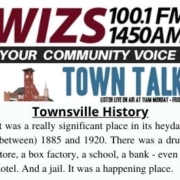TownTalk: Townsville And Its History
The tri-weekly history show on Thursday’s Town Talk takes listeners to Townsville, in northern Vance County. It has been known as Townesville and, originally, Lynnesville. L-Y-N-N-E.
That’s Lynne. Rhymes with “fine.”
Bill Harris and Mark Pace discussed the early days of the town, its heyday between post-Civil War period and the Depression, and what the area was like when railroads were the main mode of transportation for people and goods.
There’s a detailed map, drawn in pencil, that a prominent family – Adams – had made, Pace said. A copy is at the North Carolina Room at the Richard Thornton library in Oxford. It shows a prosperous area, with businesses and homes “It’s amazing how much there actually was in Townsville,” Pace said. “It was a really significant place in its heyday (between) 1885 and 1920.
There was a drug store, a box factory, a school, a bank -even a hotel. And a jail.
“It was a happening place,” Pace said. Mostly because of the railroad.
The town originally was called Lynnesville, for the Caroline County, Va. family that moved to the area. Lynne operated a store in town in the 1780’s. And it’s why John Penn, one of the signers of the Declaration of Independence, moved to Granville County. He married one of Lynne’s daughters.
The town’s name changed to Townesville to honor Edmund G. Townes who gave land on which the train depot was built. The railroad came through in 1855 and in the early 20th century when a spur line was put in between Manson and Townsville, “that’s when Townsville really hit its stride,” Pace said.
The citizens of the tiny town had a bond issue in 1920 and raised $60,000 to buy the rail line. It consisted of one freight car and one passenger car, and it went regularly between Manson and Townsville. The only trouble was there was no place to turn around in Townsville, so it had to chug in reverse all the way back to Manson.
Through the 1920’s the railroad died off, the box factory closed and Townsville became a casualty of the Depression. “Basically, it was part of the general change that was happening in America,” Pace said, of people leaving rural areas in search of jobs in more urban areas.
In 1942, two local gold prospectors from Granville County discovered something almost as good in Townsville Township. They found a rich deposit of tungsten, a hard metal that has a super-high melting temperature. Tungsten was put on the tips of missiles and artillery during World War II to penetrate tank armor.
The Allied forces didn’t have access to tungsten, and within six weeks’ time, there was a gaping open pit in Townsville and tungsten was being brought out to sell to the Army. It was dangerous work when the mining finally went underground, and Pace noted that it was one of the first places in the area that was integrated, Black and White working side by side.
The mine was in operation until 1971.
The Townsville area also produced a man by the name of Thomas Morgan, who eventually went to work for Sperry Corp. He was instrumental in creating a gyroscope used for ship navigation and also in the development of radar. “He was a big, big deal,” Pace said. Morgan, who is buried at Island Creek Baptist Church, had a famous visitor attend his funeral – U.S. Army General Omar Bradley.
Click Play and hear more


